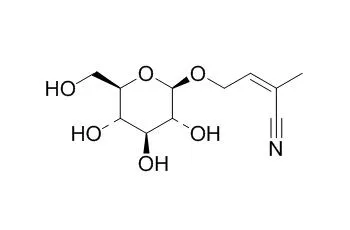| Structure Identification: |
| Nat Prod Commun. 2009 Aug;4(8):1053-8. | | Phytochemical characterization of an adaptogenic preparation from Rhodiola heterodonta.[Pubmed: 19768982 ] | The phytochemical constituents of a biologically active, standardized, 80% ethanol extract of Rhodiola heterodonta were characterized.
METHODS AND RESULTS:
The extract was fractionated over a Sephadex LH-20 column to afford two main fractions representing two classes of secondary metabolites: phenylethanoids and proanthocyanidins. This fractionation facilitated the identification and quantification of individual compounds in the fractions and sub-fractions using HPLC, and LC-MS. The major compounds in the phenylethanoid fraction were heterodontoside, tyrosol methyl ether, salidroside, viridoside, mongrhoside, tyrosol, and the cyanogenic glucoside Rhodiocyanoside A. These seven compounds comprised 17.4% of the EtOH extract. Proanthocyanidins ranged from oligomers to polymers based on epigallocatechin and gallate units. The main identified oligomeric compounds in the proanthocyanidin fraction were epigallocatechin gallate, epigallocatechin-epigallocatechin-3-O-gallate and 3-O-galloyl-epigallocatechin-epigallocatechin-3-O-gallate, which constituted 1.75% of the ethanol extract.
CONCLUSIONS:
Tyrosol methyl ether, mongrhoside, and the two proanthocyanidin dimers were reported for the first time from this species in this study. Intraperitoneal injection of the 80% ethanol extract increased survival time of mice under hypoxia by 192%, as an indication of adaptogenic activity. |
|






 Cell. 2018 Jan 11;172(1-2):249-261.e12. doi: 10.1016/j.cell.2017.12.019.IF=36.216(2019)
Cell. 2018 Jan 11;172(1-2):249-261.e12. doi: 10.1016/j.cell.2017.12.019.IF=36.216(2019) Cell Metab. 2020 Mar 3;31(3):534-548.e5. doi: 10.1016/j.cmet.2020.01.002.IF=22.415(2019)
Cell Metab. 2020 Mar 3;31(3):534-548.e5. doi: 10.1016/j.cmet.2020.01.002.IF=22.415(2019) Mol Cell. 2017 Nov 16;68(4):673-685.e6. doi: 10.1016/j.molcel.2017.10.022.IF=14.548(2019)
Mol Cell. 2017 Nov 16;68(4):673-685.e6. doi: 10.1016/j.molcel.2017.10.022.IF=14.548(2019)